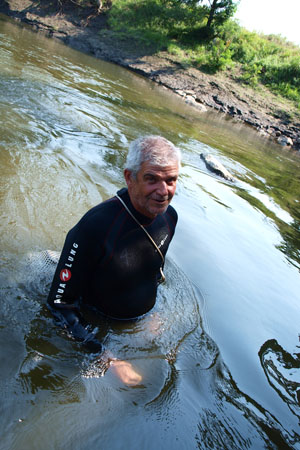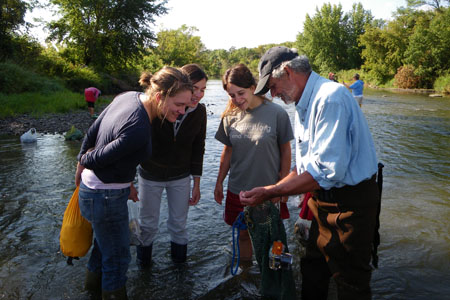Mike Davis
Malacologist, Minnesota Department of Natural Resources
Mussel research in Minnesota didn’t get started until late 1980s when people like Mike Davis entered the natural resource field. Growing up on the Mississippi River, Davis did a number of things to making a living including farming and commercial fishing. When businesses started to buy the state’s native mussels for the pearl button industry Japan and as the price from them got higher than the price of fish he started digging them out of the Mississippi. “The more I did this over one summer,” relates Mike, the more I realized there was a lot more than one kind of mussel down there. I got curious and started to read up on them and studying them. I had always been fascinated and intrigued with the river.”
Eventually Mike went back to college to finish up a degree he had put off for 15 years while having fun doing other things. In 1986, he graduated from Winona State College eighteen years after getting done with college and took a job with the DNR as a fisheries creel clerk. His job consisted of talking to fishermen on the Zumbro River asking them all sorts of fish-related questions. “I got talking to the area fisheries manager at Lake City about mussels,” says Mike. “He was interested too because of his childhood experience on the Cannon River.” The two of them approached the nongame wildlife program coordinator who had some funds to conduct a survey in this watershed.
During the summer of 1987, Davis took a leave of absence from his creel clerk job to conduct this mussel survey using his own car. From that temporary position Mike went onto a permanent one at the Lake City and today specializes in freshwater mussel ecology. Mike focuses primary on the Mississippi River drainage and played a major role in the plan to revive the endangered Higgins Eye mussel. Over the years Mike has presented his research all across Minnesota, helped start a citizen mussel survey program for Rivers Council of Minnesota, and connected the public to this important natural resource through hands-on activities like mussel hikes.
“The Minnesota River is the lowest categories of rivers for mussels in the state,” reports Mike Davis. “I think the Minnesota is the bottom of the list statewide. It is even worse than the Red River if you can believe that. There is a relationship between the land use and water quality. The areas that are more forested like the St Croix Watershed are kind of our gem because it has a lot of species and pretty much all of them are still there. More stable, less turbidity, less nutrients.”
MEET THE EXPERT VIDEO



